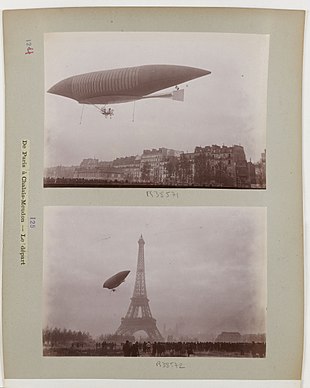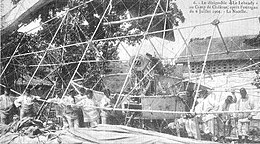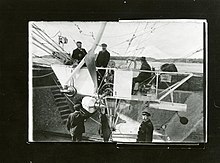Lebaudy (airship)
The Lebaudy was a semi-rigid French airship built in 1902 . It set a world altitude record and became the world's first airship in military service. Some publications mention the common nickname Le Jaune ("The Yellow") as the airship's baptismal name.
history
The brothers Paul and Pierre Lebaudy were considered France's most important sugar manufacturers around 1900. Among other things, they operated a large sugar refinery in Moisson, northwest of Paris . Influenced by the rapid development of the auto industry, she and Henri Julliot, the technical director of their company Lebaudy Frères , switched their interests to aviation.
An airship hangar was built on the outskirts of Moisson from August 1901 . After many preliminary tests, the brothers had the parts of their airship built by the designer Édouard Surcouf in 1902 and assembled them in their hangar.
From November 1902 to the end of 1903, the Lebaudy made a total of 33 journeys of increasing length in the vicinity of Moisson, divided into four campaigns. In between, the hydrogen gas balloon filling was deflated, the airship was carefully inspected and improved. The regular crew consisted of the pilot Georges Juchmès, who later also worked as a designer, and the flight engineer Antoine Rey. After a trip on November 13, 1903, the Lebaudy landed for the first time in Paris on the Champ de Mars and was on display in the Palais de Machines until November 19 . The next day the airship drove from Paris to the balloon airport in Chalais-Meudon . On landing, it crashed into a group of trees because of a communication problem with the holding team. The balloon envelope was badly damaged, the crew and engine were intact.
Since a repair would be tedious and winter was imminent, the Lebaudy was completely dismantled and its parts were used in La Villette in a branch of the Lebaudy sugar refinery that had been converted into a balloon workshop . The mechanical part of the airship was brought by water from La Villette to Moisson in June 1904, the newly constructed balloon envelope in July.
On August 4, 1904, the partially renewed Lebaudy began its fifth campaign. On the twelfth journey on August 28, the freshening storm prevented the return to the hangar. After landing on the edge of a forest, gusts tore the airship, which was tied to two trees by its crew with the tethering lines. It drifted west for 70 km at high speed and ended up hanging on an oak tree between Lisieux and Bernay , prow up. The almost undamaged Lebaudy was dismantled by numerous onlookers . A convoy of horse carts was used to transport them back to Moisson.
From October, the re-assembled Lebaudy made new trips . As a test of the new headlights also at night for the first time. The 23rd trip of the year took place on November 20th. At the Salon d'Automobiles in 1904, a 1.5 m long model of the Lebaudy was exhibited.
In July 1905, the Lebaudy brothers offered their airship to the French military. Test drives took place from July 3rd. On July 6th, the Lebaudy was officially handed over to the army in Châlons . This made it the world's first airship in military service. The following night a gust of wind pushed it into a row of trees and tore its cover. The airship wreckage was brought to Toul for repairs . A makeshift hangar had been set up here. After the restoration, with a few changes, a series of test drives took place in October and November. The airship achieved a world record for altitude of 1375 m on November 10th. Then the Lebaudys received the Lebaudy back. The military ordered an airship of the same design from them, the Patrie .
The Lebaudys offered their airship stored in Toul on December 8th to the new Minister of War Eugène Étienne and sold it to the French army for 80,000 francs.
In 1908, the Lebaudy was technically adapted to the later delivered airship République . After the loss of the République , the Lebaudy served in Chalais-Meudon for airship training. It was used until 1910 and scrapped in 1912.
description
Lebaudy
An innovation of the Lebaudy compared to other airships was a platform made of steel tubes that was tied to the underside of the balloon envelope. The compact gondola made of tubular steel hung under the platform. The gondola offered space for three people and the 370 kg engine. The 40 hp "Mercedes" -Vierzylinder drove two propellers on the sides of the gondola to 1200 min -1 at. Rudder and elevator were attached to the stern of the platform. Ballonets with a volume of 300 m 3 were installed in and behind the center of the balloon envelope.
The shell, manufactured by Surcouf in 1902, consisted of two layers of cotton fabric coated with vulcanized rubber and supplied by Continental . The outside was colored with Parisian yellow. This well-covering, lightfast paint, which was later used on many airships, was intended to protect the sensitive rubber layers of the envelope from solar radiation.
Lebaudy-1bis
For the 1903 season, the suspension of the gondola on the central platform was strengthened. The airship received a new, improved balloon envelope. It was sewn together by machine from around 1400 square pieces. Despite the increased volume to 2285 m 3 , the shell weighed less than 600 kg with a length of 55 m.
Lebaudy-2
In 1904 the Lebaudy received acetylene headlights for possible night operations. There was a ballonet enlarged to 500 m 3 and again a new balloon envelope. The 550 kg envelope had a volume of 2666 m 3 with a length of 58 m and a diameter of 9.80 m . An additional inner rubber layer was supposed to protect the casing from damage observed with the Lebaudy-1bis due to contamination of the hydrogen filling. To make it easier to detect leaks , the gas was mixed with the odorous substance benzoate .
Lebaudy-3
After its accident in July 1905, the airship was rebuilt in Toul. A new engine developed 50 hp. The new 56.5 m long balloon envelope had a volume of 2950 m 3 with a diameter of 10 m . The cover now consisted of three layers of fabric. A cross-shaped tail unit was attached to its stern.
Lebaudy IV
The Lebaudy was brought closer to the technology of the Patrie und Republique in 1908 through reconstruction . The new engine was a 70 hp Panhard & Levassor . With a length of 61 m and a diameter of 10.3 m, the new envelope had a volume of 3300 m 3 .
Nickname
The Lebaudy received the nickname Le Jaune ("The Yellow") because of its balloon envelope, which was first dyed with Parisian yellow. Since other airships built later in France also had this color, Les Jaunes ("The Yellow") became a synonym for French airships in press releases in the following years.
Web links
Individual evidence
- ↑ a b Robert Capry, M. Poncelet: Moisson, berceau of ballons Dirigeables. (PDF; 66 kB) Accessed July 27, 2017 (French).
- ↑ a b c d e Le dirigeable Lebaudy pendant les années 1902 et 1903. impr. de L. Desmolins (Mantes), 1904, pp. 1–15 , accessed on July 27, 2017 (French).
- ^ G. Besançon: Première campagne d'essais du "Lebaudy 1904". l'Aérophile, September 1904, pp. 201-207 , accessed on July 27, 2017 (French).
- ^ AM: Nouvelles expériences du "Lebaudy 1904". l'Aérophile, November 1904, pp. 256–261 , accessed on July 27, 2017 (French).
- ↑ a b c Le dirigeable le "Lebaudy" militarisé 1905 et 1908-1909. Retrieved July 27, 2017 (French).
- ↑ a b c d e f g Jean-Claude Cailliez: Premier dirigeable militaire en service au monde, le Lebaudy, avec l'aide de Liwentaal (dès 1903). June 1, 2006, accessed July 27, 2017 (French).
- ^ L. Lagrange: Le nouvel autoballon militaire français. l'Aérophile, February 1, 1909, pp. 45–49 , accessed on July 27, 2017 (French).
- ↑ a b c d e Airships Designed By Henri Julliot For Lebaudy Frères. from D'Orcy's Airship Manual , New York, 1917. Retrieved July 27, 2017 (English).





